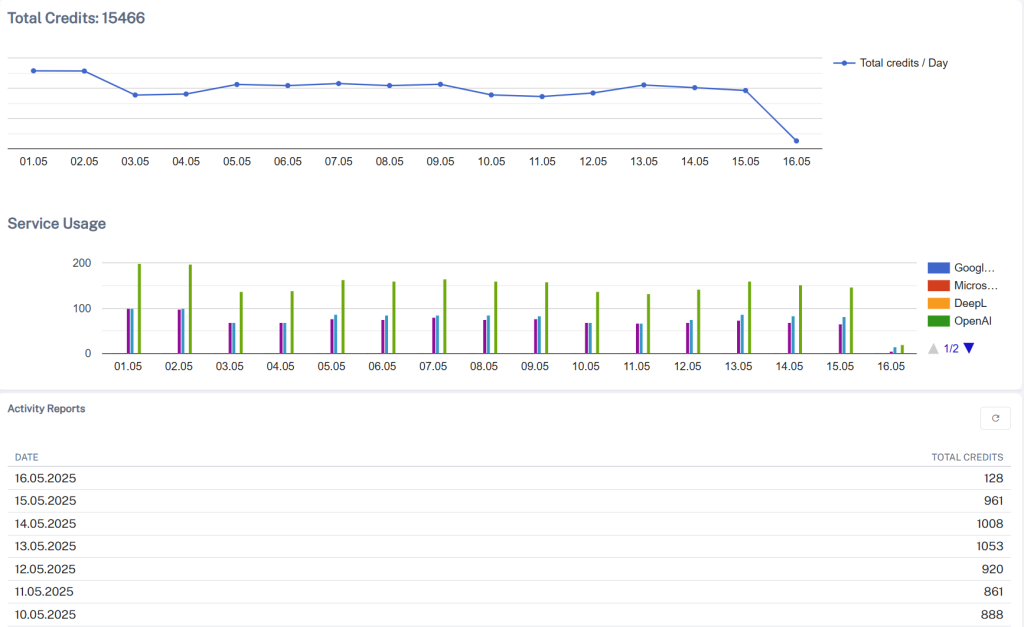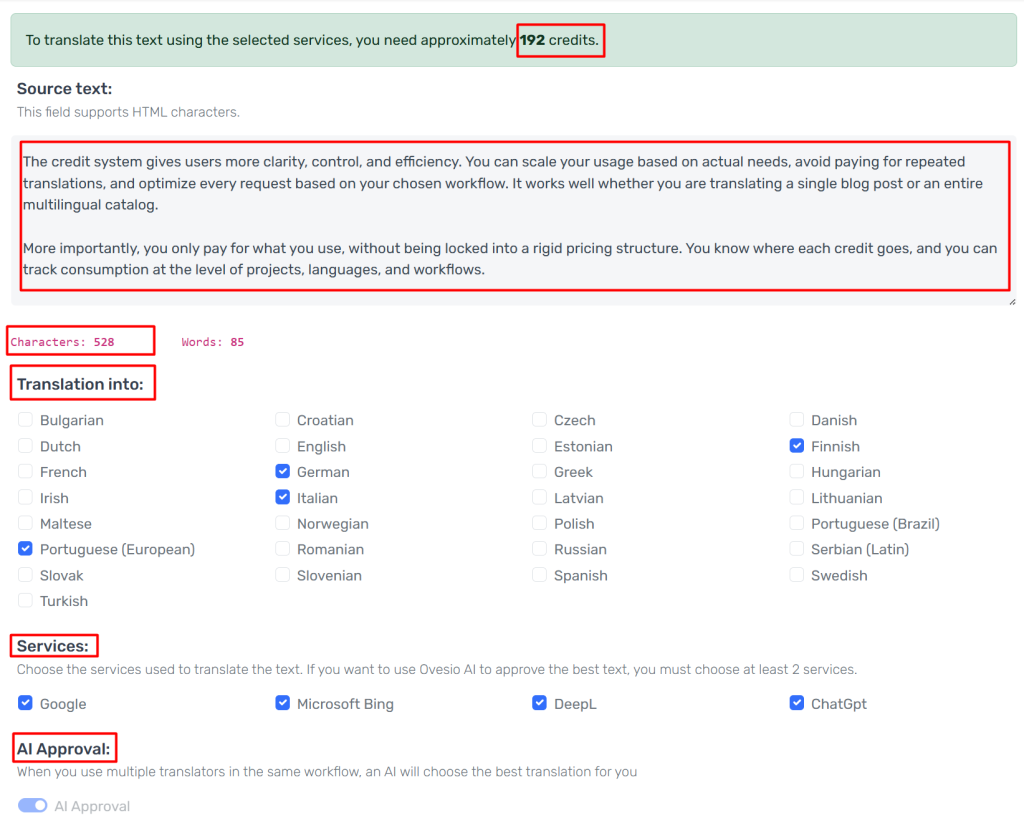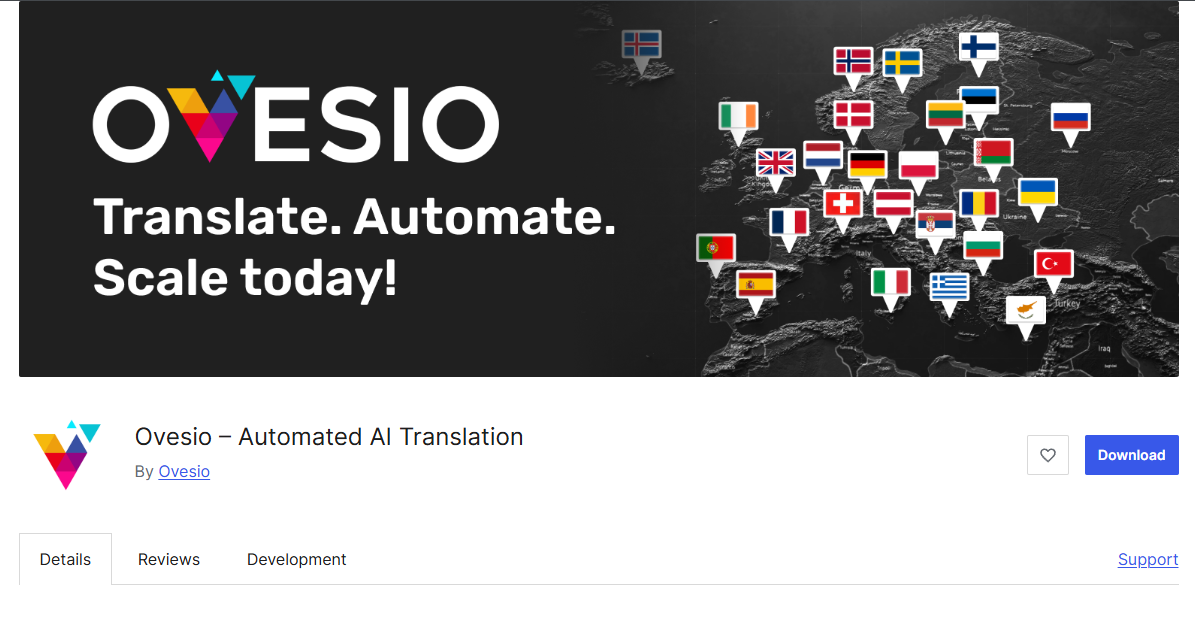Credits – How Our Pricing Model Works

When you use a translation or content generation tool, one of the most common questions is how do you pay for what you use. Ovesio takes a transparent and flexible approach to pricing by using a system based on credits.
In this article, we will explain what credits are, how they are consumed, and why this model is fair and predictable for users who need to translate and manage content at scale.
What Are Credits in Ovesio
Credits are the internal unit Ovesio uses to measure and bill usage. Every action you perform in the platform, whether it is translating content, generating text, or creating meta tags, consumes a certain number of credits. The cost in credits reflects what external services are used and how much content is being processed.
Credits are not the same as tokens, which are often used in raw AI APIs like OpenAI. Ovesio simplifies this by unifying all services under a single credit-based system. You do not need to worry about how different providers calculate usage or how much each API call costs. Ovesio handles that for you and offers a clear and unified model.
How Credits Are Consumed
Whenever you send content for translation or generation, Ovesio processes your request using the workflow you selected. A workflow defines which translation engines are used, in what order, whether to clean the HTML content of unnecessary code like class or style attributes, and whether to trigger a callback once the process is finished.
If no custom workflow is selected, Ovesio uses a default one, which includes all four translation engines available on the platform: Google, DeepL, Microsoft, and OpenAI, plus an internal step for review and approval.
The number of credits used depends on several factors:
- The amount of text being processed
- The number of languages selected
- The engines included in the chosen workflow
- Whether the content has already been translated before
If you request the translation of content that was already processed in the past and has not been changed, Ovesio will automatically detect that and reuse the saved result. In this case, no credits are consumed again. The same principle applies if the content matches a predefined translation that exists in your library of saved phrases or attributes.
Monthly Credits and Subscription Plans
Each Ovesio subscription plan includes a set number of credits added to your account every month. The number of monthly credits depends on the plan you choose. These credits are valid for the current billing month. If they are not used by the end of the cycle, they expire and are replaced with a new batch of credits in the next billing period.
If at any time you need more credits than what is included in your subscription, you can purchase extra credit packs. These additional credits are valid for twelve months from the date of purchase and can be used anytime, even across multiple projects or types of operations.
This setup gives you both structure and flexibility. You have a reliable monthly allowance and the option to scale usage when needed without upgrading your plan immediately.

What Can You Use Credits For
Credits in Ovesio are not tied to one specific feature. They can be used across all the major operations available on the platform, including:
- Translating content into one or more languages
- Generating new text using AI engines
- Creating meta titles and meta descriptions
- Submitting large batches of data like product catalogs or article collections
Everything inside Ovesio that consumes resources is powered by this same credit system.
Estimate Credits Before You Start
To help users plan ahead and understand what to expect, Ovesio offers a simple online calculator where you can estimate how many credits you need based on the type and size of your content. You can access the calculator at:
https://ovesio.com/pricing-calculator
It is useful for both new users exploring the platform and teams who want to budget their usage across projects.

Why the Credit Model Works
The credit system gives users more clarity, control, and efficiency. You can scale your usage based on actual needs, avoid paying for repeated translations, and optimize every request based on your chosen workflow. It works well whether you are translating a single blog post or an entire multilingual catalog.
More importantly, you only pay for what you use, without being locked into a rigid pricing structure. You know where each credit goes, and you can track consumption at the level of projects, languages, and workflows.
Conclusion
Ovesio’s credit-based model is designed for real teams, real content, and real usage. It offers predictable monthly allowances, flexible top-ups, and intelligent logic that avoids unnecessary charges.
If you need a content platform that can scale with your needs while staying fair and transparent, Ovesio provides the tools and structure to make that possible.





